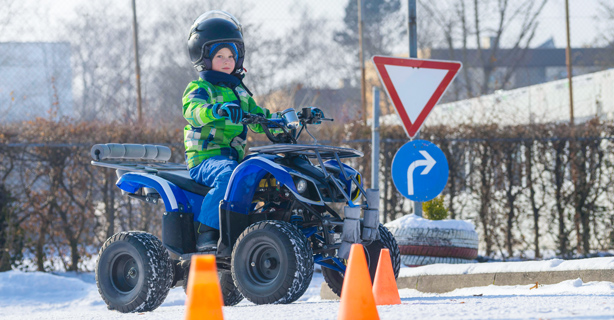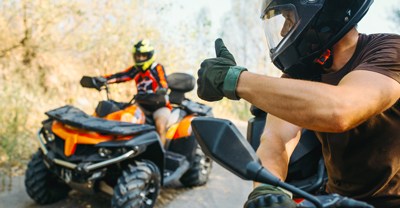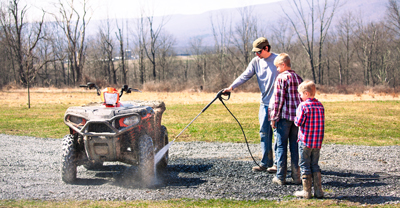Kids’ off-road vehicle safety: A guide for parents


0 min. read
Have you been thinking of taking your family on an off-road adventure? All-terrain vehicles (ATVs), utility task vehicles (UTVs), and other off-road vehicles (ORVs) are a unique and exciting way to explore the outdoors. With the growth of rental companies, more families can experience this adventurous hobby. But, before you let your kids take off down the trail, it’s important that you understand the risks involved. These powerful machines require skill and good judgement. Here’s what you need to know before letting your kids hop on a four-wheeler.
Should kids operate ATVs?
Not according to the Consumer Product Safety Commission (CPSC), the American Academy of Pediatrics (AAP), and other experts. They argue that children younger than 16 lack the strength, coordination, and decision-making skills to safely drive these off-road machines. Youth model ATVs can help children achieve the full range of motion needed for steering, braking, and accelerating, but deficits in self-control, discipline, and focus still make injuries likely.

State regulations for ORV riders under 18
Most states have laws governing the use of ORVs, but it’s important to confirm the regulations where you’re going to ride. More than 25 states have minimum age requirements, and some mandate helmets and safety training for minors.
Keep in mind, many of these regulations apply only on public lands. Different regulations may apply if you’re riding on private property, including farms.
Safety tips for youth ATV/UTV operators
If you choose to let your child operate an ORV, make sure you both have a thorough understanding of how to safely operate it. Here are some key points to emphasize:
Focus on the ride: Keep your eyes on the trail and avoid distractions
Stay in control: Keep feet on the footrests and hands on the handlebars at all times
Respect your machine: Keep hands and feet away from hot and moving parts
Follow speed limits: Drive slowly and leave stunts to the pros
Maintain space: Keep a safe distance between you and other ORVs
Be aware of your conditions: Don’t ride in the dark, extreme weather, or in unfamiliar locations

To prevent losing control and flipping over, drive in a low gear while descending, shifting your weight to the rear of the ATV.

On uphill terrain, shift your weight forward, standing on the footboards of the ATV and leaning over the handlebars if necessary. Keep an even pace and avoid sudden changes.

When turning, be mindful of your speed and environment. Shift yourself forward on the seat and lean into the turn.

Most ATVs are designed for a driver only. The long seat allows you to shift your weight and maneuver adequately. Passengers reduce your balance and vehicle control and can easily fall off the back at high speeds.

Collisions with other vehicles, trees, chains, barbed wire, and other hazards can lead to you being ejected from the ATV and seriously injured. Always be aware of your surroundings, drive at a reasonable speed, and avoid public roads.
Enroll your kid in an ATV safety course
A key contributing factor to many ATV accidents is underestimating the skill needed to safely operate the vehicle. ATVs have a narrow wheelbase and are easy to throw off-balance, especially while turning or riding on uneven ground. A practical, hands-on safety course can help equip your kid with the skills they need for off-road success.
Look for a course tailored to your child’s age group. Even getting a feel for driving the ORV under the supervision of an expert—especially if they’re a non-driver—can instill good habits and confidence.
One study of nearly 5,000 Iowa students found that over one-fifth had been in a crash where they were ejected from the vehicle or rolled over in the previous 12 months.* Only 15–26% had received any kind of education or training and even fewer—5% on the high end—had completed an ATV certification course with hands-on training.*
While the study didn’t correlate training courses with fewer injuries, they did find that kids who go through formal ATV safety training are more likely to stick to safe riding habits like wearing a helmet, avoiding paved surfaces, and allowing only one rider at a time.
Don’t allow kids to ride adult-sized ATVs
Up to 95% of youth ATV fatalities occur when kids under the age of 16 ride adult-sized ATVs.* Full-sized ATVs are built for power and speed, weighing up to 900 lbs., with engine displacement as large as 700cc and a top speed of 80 mph.
Generally, kids don’t have the weight or strength to safely be an active rider of a machine this large. Riders need to be able to shift their body weight with the ATV to keep it upright and be able to push it off themselves in the event of a rollover. And while speed obviously increases the potential for injury, it also forces them to make quick decisions on changing terrain.
In response to increasing youth injury rates, manufacturers began developing lightweight youth-sized ATVs with a lower seat height, wider wheelbase, and throttle limiters in the early 2000s. National consumer organizations then developed standards for ATV manufacturers, including the development of four age groups with corresponding speed and power restrictions.
Youth-sized age classification | Maximum limited speed capability | Maximum unrestricted speed capability | Comparable Maximum ATV engine size |
|---|---|---|---|
Y-6+: children 6 years old and older | 10 | 15 | 70cc |
Y-10+: children 10 years old and older | 15 | 30 | 70cc |
Y-12+: children 12 years old and older | 15 | 30 | 90cc |
Transition: children 14 years old and older | 20 and 30 | 38 | 90cc |
It’s important to note that child-health advocates have pointed out that the classifications aren’t backed by evidence-based studies. Despite the rising number of ATVs in use in the US, safety research has lagged.
If your child is riding a youth-model ATV, you should be present whenever your kid is riding. Supervision, along with a focus on safety—like ensuring your child always wears a helmet when on the ATV—can help keep them safe while enjoying a ride on the trail.
Avoid 3-wheel ATVs
Three-wheel ATVs have been banned in the United States since 1988. While these ORVs were popularized in the 1970s, it soon became apparent that the three-wheeled design was unstable, especially in the hands of youth riders, who were the primary target.
More than 300,000 injuries and 1,000 deaths associated with three-wheelers between the years of 1983 and 1988* prompted the U.S. government to implement the ban. It also prompted manufacturers to put a renewed emphasis on safety, resulting in a lot of the codified standards we have today.
You can still find three-wheel ATVs on the secondhand market, but don’t purchase them. If you’re looking to buy a secondhand ORV, go with more stable, four-wheeled options.
Don’t ride on the back of ATVs
The general rule for ORVs is to never carry more riders than there are seats. Side-by-sides and other UTVs are designed to carry more than one person, but a typical straddle-style ATV is a solo vehicle. If you ride with a passenger, you can upset the weight distribution and tip more easily.
Even though it’s common practice, it’s dangerous for small children to ride with adults. If seated in front of you, a child can access the controls of the ATV, distract you, and obscure your sightlines. Kids riding on the back of an ATV—either straddling the seat or sitting on the back—can easily fall off and get hurt.
Avoid riding your ATV on paved and public roads
Despite their name, ATVs aren’t safe on all terrains. ATV tires are designed with an aggressive tread that can make them unpredictable on a paved surface. If your steering and handling are impaired, you’re more likely to collide with objects near the road, like mailboxes and light posts, crash with another vehicle, or roll over. Injuries from roadway crashes are often more severe than those from off-road accidents.
In fact, more than half of ATV deaths occur on public roadways.* Despite this danger, some localities have legalized ATV traffic on public roads. Before riding, make sure to check your local laws. Many places have regulations that bar children from riding on public roads, except for designated trail crossings.
Supervise kids riding ATVs
Kids under 16 should be supervised any time they use an ATV. If you’re watching, kids are more likely to wear their protective gear and make better choices. You’re also there to correct missteps and make sure young riders follow the rules.
For older children and young adults, the buddy system is a great way to keep each other accountable and make sure they’re not alone in case of a malfunction or crash.

ATV safety features and gear
With proper preparation and the additional safety features built into youth-model ATVs, you and your kids can help reduce your risk of dangerous incidents.
Speed limiters on youth ATVs
You can manually adjust the top speed on most youth-model ATVs based on the age, maturity, and experience level of the rider. Check your owner’s manual for instructions on how to adjust your model’s speed limiter.
Remote shut-off controls on youth ATVs
Remote shut-off features come in several styles. Some models come with a rider tether that cuts power to the engine if it’s removed, like in the case of a fall or crash.
Others allow parents to shut off the engine from a long distance using a remote control or app. These features are great for peace of mind. If your child loses control of their ORV, a remote kill switch can help you properly respond to the incident.
Youth ATV helmets and safety gear
Head and neck injuries are some of the most common and serious risks facing youth ATV riders, which is why a proper helmet is so important. Some states even require children to wear helmets while operating ORVs.
Look for ATV helmets that have been safety tested and approved by ANSI, the DOT, or SNELL. They should fit snugly and securely while maintaining a clear field of vision. Full-face helmets are the safest option, but if your helmet doesn’t have a face shield, you can use an approved pair of goggles.
Along with a helmet, proper ORV gear includes:
over-ankle lace-up boots
gloves
long pants
long-sleeved shirt or jacket.
You may want to adjust pieces of gear based on the weather and terrain. A forest trail, for example, may call for a tougher jacket to protect from brush punctures.
Visibility aids for youth-model ATVs
To discourage night riding—which is statistically more dangerous than riding in daylight—many manufacturers don’t equip their youth-model ATVs with headlights. However, if you’re going to be riding on public trails or in inclement weather, it’s important to make sure your child can see and be seen in all situations.
You can add reflectors, lights, and brightly colored whip flags to your child’s ATV to make them more visible from a distance and in dense landscapes.
The general information in this blog is for informational or entertainment purposes only. View our blog disclaimer.
*Data accuracy is subject to this article's publication date.










